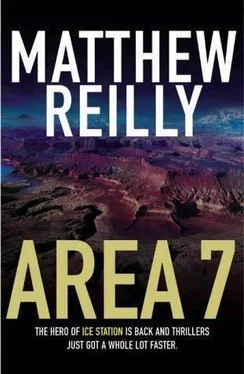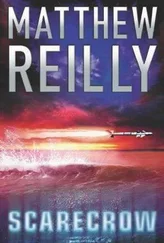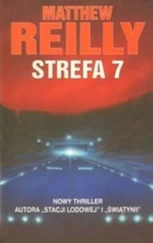Matthew Reilly - Area 7
Здесь есть возможность читать онлайн «Matthew Reilly - Area 7» весь текст электронной книги совершенно бесплатно (целиком полную версию без сокращений). В некоторых случаях можно слушать аудио, скачать через торрент в формате fb2 и присутствует краткое содержание. Жанр: Старинная литература, на английском языке. Описание произведения, (предисловие) а так же отзывы посетителей доступны на портале библиотеки ЛибКат.
- Название:Area 7
- Автор:
- Жанр:
- Год:неизвестен
- ISBN:нет данных
- Рейтинг книги:5 / 5. Голосов: 1
-
Избранное:Добавить в избранное
- Отзывы:
-
Ваша оценка:
- 100
- 1
- 2
- 3
- 4
- 5
Area 7: краткое содержание, описание и аннотация
Предлагаем к чтению аннотацию, описание, краткое содержание или предисловие (зависит от того, что написал сам автор книги «Area 7»). Если вы не нашли необходимую информацию о книге — напишите в комментариях, мы постараемся отыскать её.
Area 7 — читать онлайн бесплатно полную книгу (весь текст) целиком
Ниже представлен текст книги, разбитый по страницам. Система сохранения места последней прочитанной страницы, позволяет с удобством читать онлайн бесплатно книгу «Area 7», без необходимости каждый раз заново искать на чём Вы остановились. Поставьте закладку, и сможете в любой момент перейти на страницу, на которой закончили чтение.
Интервал:
Закладка:
had stopped beating--blood which had been supplied to the
16
Matthew Reilly
General during the two transfusions that had been required
after his unfortunate beatings at Leavenworth.
The military tribunal had said that he would never leave
federal custody alive.
They had been right.
while all this was happening, in a stark empty cell in
the Departure Lounge at Leavenworth Federal Penitentiary,
the rickety old television remained on.
On it, the newly crowned President--smiling, ecstatic,
elated--waved to the cheering crowds.
O'Hare International Airport,
Chicago, Illinois
3 July (Six months later)
they found the first one at o'hare in chicago, sitting
inside an empty hangar at the farthest reaches of the airfield.
A regulation early morning sweep with an electromagnetic
reader had revealed a weak magnetic signal emanating
from the suspect hangar.
The hangar had been completely deserted, except for
the warhead standing in the exact center of the cavernous interior
space.
From a distance, it looked like a large silver cone about
five feet tall mounted on a cargo pallet. Up close, one would
recognize it more easily as a conical warhead designed to be
inserted into a cruise missile.
Wires sprang out from its sides, connecting the warhead
to a small upwardly pointed satellite dish. Through a clear
rectangular window set into the warhead's side, there could
be seen a luminous purple liquid.
Plasma.
Type-240 blast plasma. An extremely volatile quasi
nuclear liquid explosive.
Enough to level a city.
Further investigations revealed that the magnetic signal
that had been detected inside the hangar was part of a
Area 7
complex proximity sensor array surrounding the warhead. If
anyone stepped within fifty feet of the bomb, a red warning
light began to flash, indicating that the device had been
armed.
Lease records revealed that the empty hangar belonged
to the United States Air Force.
Then it was discovered that according to the airfield's
log books, no Air Force personnel had set foot inside that
hangar for at least six weeks.
A call was made to USAF Transportation Command at
Scott Air Force Base.
The Air Force was vague, noncommittal. It knew nothing
about any plasma-based warheads at its civilian hangars.
It would check with its people and get back to O'Hare
ASAP.
It was then that reports came flooding in from around
the country.
Identical warheads--all of them surrounded by magnetic
proximity sensors; all with fold-out satellite dishes
pointing up into the sky--had been found inside empty Air
Force hangars at all three of New York's major airports:
JFK, La Guardia and Newark.
And then Dulles in Washington called.
Then LAX.
San Francisco. San Diego.
Boston. Philadelphia.
St. Louis. Denver.
Seattle. Detroit.
Fourteen devices in all, at fourteen airports across the
country.
All armed. All set. All ready to go off.
All they were waiting for now was the signal.
FIRST CONFRONTATION
3 July/ 0600 Hours
THE THREE HELICOPTERS THUNDERED OVER THE ARID DESERT
plain, booming through the early morning silence.
They flew in tight formation—like they always did
... shooting low over the tumbleweeds, kicking up a tornado of
sand behind them, their freshly waxed sides glinting in the
dawn light.
The giant Sikorsky VH-60N flew out in front—again,
like it always did—flanked on either side by two menacing
CH-53E Super Stallions.
With its pristine white roof and hand-polished dark-green
flanks, the VH-60N is unique among American military helicopters.
It is built for the United States government in a high
security "caged" section at the Sikorsky Aircraft plant in Connecticut.
It is non-deployable—meaning that it is never used
in any operational capacity by the United States Marine
Corps, the branch of the military charged with its upkeep.
It is used for one thing, and one thing only. And it has
no replicas on active duty—and for good reason, for no one
but a few highly cleared Marine engineers and executives at
Sikorsky can know all of its special features.
Paradoxically, for all this secrecy, the VH-60N is without
a doubt the most recognized helicopter in the Western
world.
On air traffic control displays, it is designated "HMX-1,"
Marine Helicopter Squadron One, and its official radio call sign
is "Nighthawk." But over the years, the helicopter that
ferries the President of the United States over short-tomedium
distances has come to be known by a simpler
name—Marine One.
22
Matthew Reilly
Known as "Ml" to those who fly in it, it is rarely observed
in flight, and when it is, it is usually in the most demure
of circumstances--taking off from the manicured
South Lawn of the White House or arriving at Camp David.
But not today.
Today it roared over the desert, transporting its famous
passenger between two remote Air Force bases located in
the barren Utah landscape.
Captain Shane M. Schofield, USMC, dressed in his full
blue dress "A" uniform--white peaked hat; navy-blue coat
with gold buttons; medium-blue trousers with red stripe;
spit-polished boots; white patent leather belt with matching
white holster, inside of which resided an ornamental nickel
plated M9 pistol--stood in the cockpit of the Presidential
helicopter, behind its two pilots, peering out through the
chopper's reinforced forward windshield.
At five-ten, Schofield was lean and muscular, with a
handsome narrow face and spiky black hair. And although
they were not standard attire for Marines in full dress uniform,
he also wore sunglasses--a pair of wraparound anti
flash glasses with reflective silver lenses.
The glasses covered a pair of prominent vertical scars
that cut down across both of Schofield's eyes. They were wounds from a previous mission and the reason for his operationatcall-sign,
"Scarecrow."
The flat desert plain stretched out before him, dull yellow
against the morning sky. The dusty desert floor rushed
by beneath the bow of the speeding helicopter.
In the near distance, Schofield saw a low mountain--
their destination.
A cluster of buildings lay nestled at the base of the
rocky hill, at the end of a long concrete runway, their tiny
lights just visible in the early light. The main building of the
complex appeared to be a large airplane hangar, half-buried
in the side of the mountain.
It was United States Air Force Special Area (Restricted)
7, the second Air Force base they were to visit that day.
"Advance Team Two, this is Nighthawk One, we are on
Area 7 23
final approach to Area 7. Please confirm venue status," the
pilot of Ml, Marine Colonel Michael "Gunman" Grier said
into his helmet mike.
There was no reply.
"I say again, Advance Team Two. Report."
Still no reply.
"It's the jamming system," Grier's copilot, Lieutenant
Colonel Michelle Dallas, said. "The radio guys at 8 said to
expect it. These bases are all Level-7 classified, so they're
covered at all times by a satellite-generated radio sphere.
Short-range transmissions only, to stop anybody transmitting
information out."
Earlier that morning, the President had visited Area 8, a
similarly isolated Air Force base about twenty miles to the
Читать дальшеИнтервал:
Закладка:
Похожие книги на «Area 7»
Представляем Вашему вниманию похожие книги на «Area 7» списком для выбора. Мы отобрали схожую по названию и смыслу литературу в надежде предоставить читателям больше вариантов отыскать новые, интересные, ещё непрочитанные произведения.
Обсуждение, отзывы о книге «Area 7» и просто собственные мнения читателей. Оставьте ваши комментарии, напишите, что Вы думаете о произведении, его смысле или главных героях. Укажите что конкретно понравилось, а что нет, и почему Вы так считаете.











